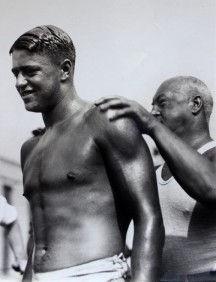By Alan F. Nelson
Wham! The reverberation filled my grandfather’s shop.
The metal “Nelson Shoe Shop” sign again was victim to a powerful stroke from Duke Nelson’s long arms. (He was seldom called by his given name of Marvin.) He was not a relative and may have thought it was good luck to slap that sign. Duke passed by the shop on his way to Fort Dodge High School where he played basketball and ran track. His home was in the “flats” — a neighborhood down by the Des Moines River that flows through Fort Dodge. Grandpa knew who it was. Who else would be running in a T-shirt at a near zero temperature?
One day, Grandpa Nelson had had enough. He greased the sign so that the next time Duke would get a hand full. There was a next time and he did, and he never banged on that sign again.
Duke would go on to become a swimming sensation known around the world. He won five marathon swims billed as World Championships because they drew the finest swimmers from around the globe. He was a swimming machine who dominated the popular sport in the 1930s.
Duke spent hours in the YMCA pool where he was a part-time lifeguard. The YMCA had a rule that no one could swim alone, so he had to beg friends, or younger brother Dallas, to sit at poolside while he worked out.
In 1926, at age 15, Duke set a record by swimming 22 miles in the YMCA’s 20-yard pool. In later years, Duke gave credit to John Botkin, physical director at the YMCA and George Kramer, general secretary, for their encouragement.
In the summer, he would hitchhike up to West Lake Okoboji and spend his days swimming up to 20 miles, and sometimes more. The Des Moines River was also available in his backyard for closer workouts.
The two YMCA men were instrumental in urging him to enter serious competition. There was nothing more serious than the Canadian National Exhibition Marathon — the Wrigley Marathon. William Wrigley Jr., of chewing gum fame and fortune, was the sponsor. Swimmers came from all over the world to complete. The marathon swimming craze of the 1920s and 1930s was especially strong in Canada.
In September of 1928, Botkin packed up his family and took the 17 year-old Nelson with them to Toronto. Normally, the low water-temperature limit for these swim events was 62 degrees. Botkin reported the temperature of the water near shore was 45 degrees and past the breakwater it lowered to 38 and 39 degrees. He said, “The wind blew from the shore and swept all the warm surface water out of the swimming area.” Of the 367 swimmers entered, only 199 showed at the starting barges and not one would finish.
Duke’s trainer greased him down for the ordeal. Botkin then ordered him to start at 56 strokes per minute. Most contestants would be at 48 to 50. Nelson took an immediate lead and remained in the lead at three-quarters-of-a-mile when he veered diagonally off course. No one knew why he did this maneuver. He later explained that he had spotted a group of photographers gathered on the pier waiting for the leaders. Duke, realizing he couldn’t finish the race, was concerned that if he was shown competing for the $25,000 prize he would lose his amateur status and be barred from playing basketball in the upcoming high school season.
When he was finally pulled from the water his hands were paralyzed and he could not walk. Duke refused offers of brandy and hot coffee — he didn’t want to touch any stimulants except beef tea and sugar, and that only while in the water. The hospital emergency room, with other contestants, was his next stop.
TO READ MORE ABOUT THIS STORY AND OTHER FASCINATING STORIES ABOUT IOWA HISTORY, subscribe to Iowa History Journal. You can also purchase back issues at the store.

